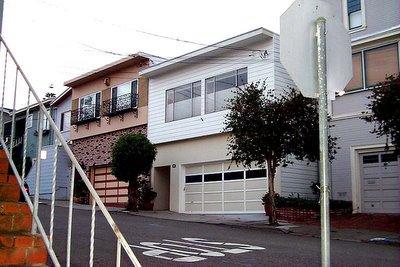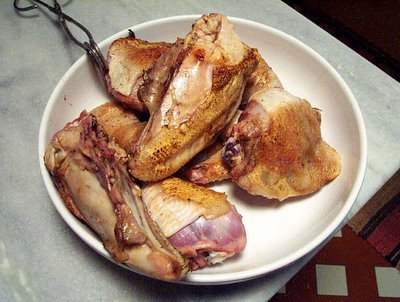I am sad to learn that Coretta Scott King passed away yesterday. She was an inspirational figure. She did much to preserve her assassinated husband's legacy and continue his work.
In the early and mid-1980s, I worked as a writer and editor for the Africa press service of the U.S. Information Agency in Washington. I traveled several times to Atlanta to do reporting at the King Center for Non-Violent Social Change. Mrs. King and Martin Luther King's sister Christine Farris were both unfailingly welcoming and forthcoming with information about the center's activities and goals.
Given the Reagan administration's suspicious and negative attitudes towards King and the U.S. civil rights movement, it was surprising to me that I would be received so kindly and openly at the King Center. I worked for Reagan, after all (that's a pretty embarrassing admission on my part). If you remember, when asked in 1983, during a press conference at the time that the Martin Luther King Jr. federal holiday was being instituted by an act of Congress, whether he agreed with Senator Jesse Helms' charge that King was a communist, Reagan replied: "We'll know in about thirty-five years." He was referring to FBI surveillance tapes on King that a court had ordered sealed until 2027. There he went again! Reagan missed a great opportunity to just say no, I don't think King was a communist. It was a pointless and insulting comment by the U.S. President.
I spent a week at the King Center in 1984 or '85 and wrote an article about the center, which had only recently opened, for a U.S. government publication. The slanted editing that my USIA editors did on that text was a big factor in my decision to leave the USIA a year or so later. But the article, my original version, was eventually reprinted in a magazine published by the Smithsonian Institution, and Coretta King was asked to review it.
Around that time, I was assigned by USIA to cover a press conference Mrs. King was holding in Washington DC at the Department of Education. At the conclusion of the press event, Mrs. King stayed to answer questions informally. I went and spoke to her privately. She remembered me, at least vaguely, and she complimented me on the article, which she had just finished reading. She said she was surprised that I had been able to learn so much about the King Center in just one week. In reality, she and her sister-in-law deserved much of the credit for that, because they were so willing to spend time talking with me. Mrs. King's praise was one of the hightlights of my career as a political writer/propagandist for the U.S. government.
I read in the paper a few weeks ago that the King Center has fallen on hard times. That is also a sad development. I'm sure Mrs. King's declining health has been one of the reasons for the turmoil there.
31 January 2006
Hooked on onions
We finished that 5 kg/12 lb. bag of onions we were working on. Today we went grocery shopping at Intermarché. I had onions on the shopping list. When I saw the price per kilo, I was shocked. 90 euro cents a kilo! Last time, chez Ed, I paid 85 euro cents for FIVE kilos.
Then I noticed that Intermarché had a 5 kg bag of onions for 1.95 euros. That's a lot more than the last 5 kg bag I bought, but a lot better than 90 cents a kilo.
So I'm working on using up (and enjoying) onions again. Some things never change.
And here, by the way, was this morning's sunrise.
Then I noticed that Intermarché had a 5 kg bag of onions for 1.95 euros. That's a lot more than the last 5 kg bag I bought, but a lot better than 90 cents a kilo.
So I'm working on using up (and enjoying) onions again. Some things never change.
And here, by the way, was this morning's sunrise.
Going to Amboise
Where in France? That was the question.
Walt and I had been spending our vacations in France since 1988. We had spent more time in Paris than anywhere else. But in 1989 we had done a driving tour in the south and southwest, visiting Grenoble, Nîmes, Narbonne, Carcassonne, Bordeaux, Cognac, Poitiers, and Chartres. That covered a lot of territory. In 1992, we did a driving tour of Normandy and Brittany, returning to Paris on a route that took us through the Loire Valley. In 1993, we spent two weeks in Provence. On that trip, we drove through Burdundy on the way south and through the Massif Central on the way back to Paris.
In 1994, we went on a day trip to Champagne, and in 1995 we spent 10 days near Cahors, with visits to Toulouse, Agen, Rocamadour, and Albi. We had friends in Normandy and on many trips we spent a few days with them while we were in France. In 1997, 1998, and 1999, we focused on Paris, renting apartments in the city for a couple of weeks at a time.
In October 2000, after deciding to abandon a plan to go spend two weeks in Alsace, we ended up renting a gîte (a small house rented for short stays) in Vouvray, near Tours in the Loire Valley. We spent a week in Vouvray, and then a week in Champagne, and another week in Paris. We liked Vouvray and the house we rented there so much that we decided to rent it again in June 2001, for two weeks. We loved it the second time, and traveled by car all over the region.
In September 2001, we returned to Provence for a two-week stay in a gîte near Cavaillon. In April 2002, we spent two weeks in an apartment in Paris, near Montparnasse, with another side trip to Normandy. The euro was new then, and it was very low against the dollar. Everything in Paris seemed very inexpensive then, compared to San Francisco. In addition, I had very severe springtime pollen allergies in California, but when we arrived in Paris all the symptoms went away. That had happened once before, when I went to Seattle for a conference in March. What a pleasure it was to be in Paris in the springtime!
I say all that just to make it clear that we knew France well and knew what different regions were like. We both understand and speak French well. I lived and worked in France for about eight years in the 1970s and early 1980s. Walt spent a year in Paris as a student in the early 1980s. We love French popular music and have a good collection of CDs that we listened to a lot -- that's a great way to improve your French comprehension and pronunciation. We had a French-language television channel (TV5) in San Francisco via satellite.
In October 2002, then, the French-countryside experience that was freshest in my mind was the place in Vouvray, in the Loire Valley. I had several reasons for not wanting to relocate to Provence or the French Southwest, among them the distance from Paris and the possibility that my pollen allergies might to be aggravated by plants native to the south of France. After our April 2002 trip to Paris and Normandy, my allergist in San Francisco had recommended that I leave California and go live either in the Pacific Northwest or northern France. Doctor's orders...
I was going to start researching real estate possibilities in the northern French countryside, and what better place to start with than the Loire Valley, then? We had enjoyed our vacations in Vouvray, and had toured around quite a bit from Angers to Chinon and Bourgueil, from Amboise and Montrichard to Blois, Chambord, and Romorantin.
Finding French real estate agencies on the Internet was easy. We decided to start looking around Amboise. It’s a beautiful town of about 15,000 people, and it’s far enough from Tours to be outside the suburban ring. Vouvray was nice, but it really is the suburbs of Tours these days. I quickly found quite a few houses for sale within 25 miles or so of Amboise that looked attractive and affordable. I studied several real estate sites, including FNAIM and ORPI.
After a few days of searching, I sent a couple of e-mails to real estate agents in Amboise. One answered promptly and said he would be glad to help me find a place to buy. This whole endeavor was starting to get serious. I told Walt we needed to schedule a trip to the Loire Valley to see if the houses I was seeing on Internet sites were all located near garbage dumps or in the shadow of nuclear power plants. He examined his schedule and we decided to go spend a week in Amboise in early December.
Early December is a good time to travel. The airlines offer good fares. It’s easy to find places to rent — we found a gîte on the northern outskirts of Amboise with no trouble. We rented it for a week for about $350. I wrote back to the real estate agent in Amboise who had answered my initial e-mail and told him we would like to come see some houses that week.
The fact was, I thought it was unlikely that we would see very many houses in one week. I’ve spent enough years in Paris to develop a tough sense of realism about how long it can take to get anything done in France. Things move slowly. I told Walt that we might get to Amboise only to find out the real estate agent was too busy to help us right then. We might spend a week there without seeing a single house. But what the heck, it was a week in France, n’est-ce pas? It was a good Christmas present to ourselves, if nothing else. We could at least drive around and look for "for sale" signs.
I told the agent in Amboise that we would be there on a Monday morning in early December, raring to go. He answered immediately and said that sounded good, but his office in Amboise was closed on Mondays. Would we mind coming to his office in Montrichard? It would be open that morning. We had visited Montrichard two years earlier, so we knew it was only 10 miles south of Amboise. We remembered it as a nice little town on the banks of the Cher River. I sent back an e-mail saying that coming to the office in Montrichard on that Monday was not a problem. He answered and said we had an 11:00 appointment.
When December came, we flew to Paris and arrived on a Saturday morning. We picked up a rental car (a nice Peugeot 307) at the airport and drove the three hours down to Amboise. The owners of the gîte we had rented had given us directions to their house, and we found it without too much trouble. We checked in and then immediately drove over to Vouvray, familiar territory seve or eight miles west, to visit the Atac supermarket that we had liked there. We bought milk, butter, sugar, mustard, vinegar, oil, and other staples for the kitchen. It felt good to be back in Vouvray.
The next morning, Sunday, there was a big food market in Amboise, the gîte owners told us, and it turned out that jet lag had us up and going early that day. We were at the market by 8:30 a.m. We bought what we needed and wanted to make lunch at the gîte, and then went back to prepare a hot meal. That afternoon, rather than give in to jet lag, we took a long walk around the area, looking at houses (even though they were not for sale) and talking about how much we liked this one or that one and how great it would be to live in such a place.
The weather was cold, gray, and damp. We were of course exhausted after the overnight flight. The gîte owners, Adrienne and Jean, told us there was plenty of firewood in the shed next to our place and said we should take what we wanted. Walt built a fire and we watched French television that Sunday evening, wondering what Monday was going to be like.
Walt and I had been spending our vacations in France since 1988. We had spent more time in Paris than anywhere else. But in 1989 we had done a driving tour in the south and southwest, visiting Grenoble, Nîmes, Narbonne, Carcassonne, Bordeaux, Cognac, Poitiers, and Chartres. That covered a lot of territory. In 1992, we did a driving tour of Normandy and Brittany, returning to Paris on a route that took us through the Loire Valley. In 1993, we spent two weeks in Provence. On that trip, we drove through Burdundy on the way south and through the Massif Central on the way back to Paris.
In 1994, we went on a day trip to Champagne, and in 1995 we spent 10 days near Cahors, with visits to Toulouse, Agen, Rocamadour, and Albi. We had friends in Normandy and on many trips we spent a few days with them while we were in France. In 1997, 1998, and 1999, we focused on Paris, renting apartments in the city for a couple of weeks at a time.
In October 2000, after deciding to abandon a plan to go spend two weeks in Alsace, we ended up renting a gîte (a small house rented for short stays) in Vouvray, near Tours in the Loire Valley. We spent a week in Vouvray, and then a week in Champagne, and another week in Paris. We liked Vouvray and the house we rented there so much that we decided to rent it again in June 2001, for two weeks. We loved it the second time, and traveled by car all over the region.
In September 2001, we returned to Provence for a two-week stay in a gîte near Cavaillon. In April 2002, we spent two weeks in an apartment in Paris, near Montparnasse, with another side trip to Normandy. The euro was new then, and it was very low against the dollar. Everything in Paris seemed very inexpensive then, compared to San Francisco. In addition, I had very severe springtime pollen allergies in California, but when we arrived in Paris all the symptoms went away. That had happened once before, when I went to Seattle for a conference in March. What a pleasure it was to be in Paris in the springtime!
I say all that just to make it clear that we knew France well and knew what different regions were like. We both understand and speak French well. I lived and worked in France for about eight years in the 1970s and early 1980s. Walt spent a year in Paris as a student in the early 1980s. We love French popular music and have a good collection of CDs that we listened to a lot -- that's a great way to improve your French comprehension and pronunciation. We had a French-language television channel (TV5) in San Francisco via satellite.
In October 2002, then, the French-countryside experience that was freshest in my mind was the place in Vouvray, in the Loire Valley. I had several reasons for not wanting to relocate to Provence or the French Southwest, among them the distance from Paris and the possibility that my pollen allergies might to be aggravated by plants native to the south of France. After our April 2002 trip to Paris and Normandy, my allergist in San Francisco had recommended that I leave California and go live either in the Pacific Northwest or northern France. Doctor's orders...
I was going to start researching real estate possibilities in the northern French countryside, and what better place to start with than the Loire Valley, then? We had enjoyed our vacations in Vouvray, and had toured around quite a bit from Angers to Chinon and Bourgueil, from Amboise and Montrichard to Blois, Chambord, and Romorantin.
Finding French real estate agencies on the Internet was easy. We decided to start looking around Amboise. It’s a beautiful town of about 15,000 people, and it’s far enough from Tours to be outside the suburban ring. Vouvray was nice, but it really is the suburbs of Tours these days. I quickly found quite a few houses for sale within 25 miles or so of Amboise that looked attractive and affordable. I studied several real estate sites, including FNAIM and ORPI.
After a few days of searching, I sent a couple of e-mails to real estate agents in Amboise. One answered promptly and said he would be glad to help me find a place to buy. This whole endeavor was starting to get serious. I told Walt we needed to schedule a trip to the Loire Valley to see if the houses I was seeing on Internet sites were all located near garbage dumps or in the shadow of nuclear power plants. He examined his schedule and we decided to go spend a week in Amboise in early December.
Early December is a good time to travel. The airlines offer good fares. It’s easy to find places to rent — we found a gîte on the northern outskirts of Amboise with no trouble. We rented it for a week for about $350. I wrote back to the real estate agent in Amboise who had answered my initial e-mail and told him we would like to come see some houses that week.
The fact was, I thought it was unlikely that we would see very many houses in one week. I’ve spent enough years in Paris to develop a tough sense of realism about how long it can take to get anything done in France. Things move slowly. I told Walt that we might get to Amboise only to find out the real estate agent was too busy to help us right then. We might spend a week there without seeing a single house. But what the heck, it was a week in France, n’est-ce pas? It was a good Christmas present to ourselves, if nothing else. We could at least drive around and look for "for sale" signs.
I told the agent in Amboise that we would be there on a Monday morning in early December, raring to go. He answered immediately and said that sounded good, but his office in Amboise was closed on Mondays. Would we mind coming to his office in Montrichard? It would be open that morning. We had visited Montrichard two years earlier, so we knew it was only 10 miles south of Amboise. We remembered it as a nice little town on the banks of the Cher River. I sent back an e-mail saying that coming to the office in Montrichard on that Monday was not a problem. He answered and said we had an 11:00 appointment.
When December came, we flew to Paris and arrived on a Saturday morning. We picked up a rental car (a nice Peugeot 307) at the airport and drove the three hours down to Amboise. The owners of the gîte we had rented had given us directions to their house, and we found it without too much trouble. We checked in and then immediately drove over to Vouvray, familiar territory seve or eight miles west, to visit the Atac supermarket that we had liked there. We bought milk, butter, sugar, mustard, vinegar, oil, and other staples for the kitchen. It felt good to be back in Vouvray.
The next morning, Sunday, there was a big food market in Amboise, the gîte owners told us, and it turned out that jet lag had us up and going early that day. We were at the market by 8:30 a.m. We bought what we needed and wanted to make lunch at the gîte, and then went back to prepare a hot meal. That afternoon, rather than give in to jet lag, we took a long walk around the area, looking at houses (even though they were not for sale) and talking about how much we liked this one or that one and how great it would be to live in such a place.
The weather was cold, gray, and damp. We were of course exhausted after the overnight flight. The gîte owners, Adrienne and Jean, told us there was plenty of firewood in the shed next to our place and said we should take what we wanted. Walt built a fire and we watched French television that Sunday evening, wondering what Monday was going to be like.
Next: Monday in Montrichard
29 January 2006
Quitting California
First in a series about leaving California and moving to France. Click Next at the bottom of this article to jump to the next installment.
What possesses somebody to sell his house in the United States, sell most of his possessions, and move what’s left of his stuff to France? To a lot of people, it might seem to be an insane thing to do, I have to admit. Walt and I aren’t the only ones to take this drastic step, of course. We know two other couples from California who have bought houses in France over the past six months. And there is a lot of talk (and evidence) of the British invasion these days.
Some people might think Walt and I are “living our dream,” but for us it was a plan. The timing wasn’t planned, but we knew we were going to move to France one day. Or at least we hoped so and were planning for it. As it turned out, it happened a lot earlier than we thought it might.
It was 2002. Walt had quit a very stressful job with the city of San Francisco and gone into independent consulting. Things were going very well for him. I had tried for years to find a good job for myself in the city, but had never been successful. From 1995 until I got laid off in early 1998, I commuted about 50 miles (80 km) each way to work every day. I worked in Silicon Valley, but I didn’t want to live in Silicon Valley, for a lot of reasons.
One friend of mine who had also moved out to California from what we came to know as Back East liked to say: “I didn’t move all the way to California to live in [insert name of suburb]. I want to live in San Francisco.” I guess that’s how I felt too. Living in a place where the most distinctive landmarks are Walgreen's, K-Mart, Safeway, and Longs Drugs isn't really my idea of living.
When I got laid off by my employer, Apple Computer, in early 1998, I took almost a year off work. That was nice until reality closed in and I could no longer avoid looking for another job. Big mortgage, you know.
From 1999 until early 2002, I worked at jobs in towns just 25 or so miles south of our San Francisco neighborhood. Life was good. It took me less than 30 minutes, door to door and without fail, to get to the office in the morning. Traffic was not really an issue. I was surrounded by people I respected and enjoyed working with. I swore to myself that I would never again work farther south, farther from home. It just wasn’t worth it. I loved being in San Francisco on weekends. Walt and I started going out to dinner on Friday nights in some of the city’s nicest restaurants (mostly French) and otherwise enjoying urban life in one of the most beautiful cities anywhere — concerts, shopping, markets, interesting neighborhoods, the gorgeous landscapes and views.
By 2002, the start-up company I was working for had been sold to a much bigger company located in San Diego. That big company had also bought a company located in the heart of Silicon Valley at about the same time. Then, after several rounds of layoffs, came the dreaded announcement. Our “site” was being closed down and we were all being transferred to other offices. Most of us ended up in the heart of Silicon Valley. For many people that was a blessing — they lived down that way.
 San Francisco on a nice day in January — photo taken not from our house but from where I worked, 20 miles south of SF
San Francisco on a nice day in January — photo taken not from our house but from where I worked, 20 miles south of SFBut not for me. For me, it meant a much longer drive in much worse traffic every morning and every evening. I never knew if it was going to take me one hour or two or even longer to get to work in the morning, in stop-and-go traffic on an eight-lane freeway. I was right back where I had started — almost literally, because the first place I had ever worked in Silicon Valley, in 1989, was no more than two blocks from my new office. I had that déjà-vu-all-over-again feeling: been there, done that...
My new managers asked me to take over day-to-day management of a group of eight or ten writers and editors working on the documentation for a major update to the company’s flagship software package. The product package included many hundreds of pages of technical documentation that had to be revised to reflect changes in and additions to the product’s feature set.
I was also wrapping up a project to update a 2000-page document set for a different software package. That project required me to participate in twice-weekly, early-morning conference calls with people working in the U.K., New England, and Florida for a major computer corporation. When it was 8:00 or 9:00 a.m. in California and my day was beginning, it was 4:00 or 5:00 p.m. in the UK and things were winding down. That’s when we all had to call each other and coordinate our work.
The promise from my managers was this one: take on this new responsibility and finish up the old project. The company will give you all the flexibility you need to set your own work schedule. Work at home as necessary. Stay in touch by telephone and on e-mail. Be here to attend your meetings and to meet with the writing team as necessary. Under that arrangement, I could work at home until 9:30 or 10:00 in the morning, and then jump in the car and race south on the freeway without being stuck in rush-hour traffic. The drive took only 35 or 40 minutes, and I was in the office in time for my 11:00 meetings. I still had to deal with the traffic on the way home in the afternoon, of course.
That lasted about three months. “Starting now, all managers need to be in the building from 9:00 until 5:00 every day,” they said. I pointed out to my manager that the original agreement about my working schedule was being thrown out the window. “Sorry, things have changed,” was the answer. I calmly mentioned that I didn’t think I would last long under the new arrangement. Nobody was listening. Two months later I told Walt that I was seriously considering quitting my job. We spent a week talking about it. And then I quit.
It was October 2002. I was 53 years old. I had tried for years to find a job in my field in San Francisco. Unemployment in the area was high. The dot-com boom had ended. What job opportunities I had were in Silicon Valley. Given my age and the nature of the software business, where I was already a dinosaur, I wasn’t optimistic. Besides, I couldn’t face the prospect of another winter in my car, in the dark, in the rain, in the traffic on the freeways. Over the preceding three months, I had seen one very serious car accident happen right in front of me, and another very close call. Did I really want to die on a California freeway trying to get to work to do a job I was less and less interested in?
In talking with Walt, the subject of our retirement plan — a move to France — inevitably came into the discussion. Maybe we should start looking into buying a house over there. If we found one we could afford, it would be good motivation for me to get a new job so that we could take on, if necessary, a second mortgage. It would be something to look forward to and work toward. House prices were sky high and rising in San Francisco, so we had some equity.
Walt was doing his consulting work and was busy and happy in his job. He worked at home a lot. I needed a few weeks rest while I decided what the next step might be for me. The prospect of looking for and maybe actually buying a house in France was exciting, of course, and I had two things going for me. I had time to do some research (ah, unemployment!), and I had the tool just made for the job: a computer with a high-speed Internet connection.
We figured we had two options in France as far as location was concerned: Paris or the countryside, and nothing in between. We knew enough about Paris from spending vacations there over the preceding 10 or 12 years to realize that anything we would be able to afford to buy in the city would be a very small apartment.
We had lived in Paris in the early 1980s, and then in Washington DC for nearly five years before moving to San Francisco in 1986. We had a dog that we wouldn’t consider giving up. Maybe it was time to think about a move to the country. We didn’t really relish the idea of living in an apartment and having to walk the dog on city sidewalks morning and night. Realistically, and from experience, we knew how easy it would be to spend money in Paris. Even if we could afford to buy something there, we would be on a very tight budget if we ever decided to try to live there full time.
If I found a new job in California, we would stay in San Francisco for another five years or more. By then, we would surely be in the mood to flee the urban environment and set ourselves up somewhere in the country. The prospect of someday spending time outdoors, maintaining a yard or garden, and maybe planting a big vegetable garden, was very tempting. We would no longer have to put up with neighbor-noise. The dog would love being outside more. Okay, that was a decision. Let’s see what it might cost to buy a house in the French countryside.
Weather was another factor. One of the constant refrains you hear in the San Francisco area is a song of praise for the California climate. The fact is, many of the people our age or younger who live and work there moved out west from the U.S. Middle West or Northeast, where winters are extremely cold and snowy, or from the U.S. South, where summers are unbearably hot and humid. I’ve been lucky enough to try both.
In San Francisco, we used to brag that we didn’t need air conditioning because we didn’t have hot, humid weather in the summer. What we didn’t tell people, however, was that our furnace ran 12 months a year. On a typical summer morning in San Francisco, at least in our neighborhood, the temperature was between 45º and 55ºF — that’s 8º to 12ºC. A brisk breeze would be blowing in off the ocean, bringing in fog and mist. We needed heat, and the furnace would kick in every morning for a few hours.
 A view of the city of San Francisco from the hills north of the Golden Gate Bridge on a nice summer day
A view of the city of San Francisco from the hills north of the Golden Gate Bridge on a nice summer dayIf we were lucky the fog would clear by noon and we might have some sunshine until about 3:00 p.m., when the fog would blow back in. On many summer days, there was no sunshine at all, and the temperature would hover around 60ºF (15ºC). The furnace, with the thermostat set at 65ºF, would cycle on intermittently during the day, even in July and August. There’s some truth in that old quip attributed to Mark Twain: The coldest winter I ever spent was a month of August in San Francisco.
It’s true that winters were mild compared to most places in the U.S. In drought years, winter days were gorgeous — bright and sunny. But during normal winters we had quite a few days of cold rain. There really wasn’t much difference between winter and summer temperatures in San Francisco, in fact. Only in spring and autumn did we have a few days of warm sunshine (or even the infrequent hot day or two). I actually have an article I clipped out of the San Francisco Chronicle one year announcing that the city was experiencing its longest heat wave in history — the high temperature had been above 70ºF for 8 days in a row!
And did I mention earthquakes? I lived through the big one in 1989. That was enough, thank you, and a whole ’nother story.
So the prospect of warm summers in the country was thrilling. After all, we weren’t talking about returning to Illinois or Upstate New York, where we had lived through grueling winter snowstorms, or to Washington DC or North Carolina, where the summers are so hot and humid that you have to close all your windows and curtains and run the air conditioning full blast for weeks or months on end.
France was the answer, as we had known all along, and living in the country sounded just fine. A mild, maritime climate would do nicely. Warm summers. Real winters with a little snow now and then, but nothing hideous. Beautiful countryside. Good food — yes, good food and good wine. Good bread, of course. Good cheese. A yard big enough for a vegetable garden. Outdoor markets. No traffic. No earthquakes. Trips to Paris on a more frequent schedule than ever before. But wait, I’m getting ahead of myself.
Where in France?
Next: Going to Amboise
28 January 2006
Tempête de neige
Today we are having what is the biggest "snowstorm" we have had here over the past three winters. We figure we have about three inches of snow on the ground right now, and it is still snowing. And wouldn't you know it? I need to go out this afternoon. I absolutely have to go to the pharmacy in Saint-Aignan. I'm waiting to see if they come put some sand or salt on the road. The hill from the main road, down in the river valley, up to our house is pretty steep. I can always drive around through town and come in the back way, on the gravel road through the vineyard, if the paved road is too slippery. But it's been many years since I've had to deal with this much snow.
I did live in Champaign-Urbana, Illinois, back in the 1970s. Those winters were something to see, especially in 1977, '78, and '79. We lived through snows two feet deep and temperatures in the minus twenties fahrenheit. And then I lived in Washington, DC, where in 1983 we had nearly 20 inches of snow overnight in February. But back then I had a four-wheel drive car. Walt is from Albany, NY, so he has seen his share of snowstorms too. But after living in the San Francisco area for almost 20 years, and now here for about three, we are out of practice. The snow is exciting, but it doesn't take much to remind you how much trouble it is to cope with it.
I did live in Champaign-Urbana, Illinois, back in the 1970s. Those winters were something to see, especially in 1977, '78, and '79. We lived through snows two feet deep and temperatures in the minus twenties fahrenheit. And then I lived in Washington, DC, where in 1983 we had nearly 20 inches of snow overnight in February. But back then I had a four-wheel drive car. Walt is from Albany, NY, so he has seen his share of snowstorms too. But after living in the San Francisco area for almost 20 years, and now here for about three, we are out of practice. The snow is exciting, but it doesn't take much to remind you how much trouble it is to cope with it.
27 January 2006
A cold morning
[Click on the pictures to see a larger view.]
 Collette, our 14-year-old "puppy," heading out for her morning walk in the vineyard. We had a dusting of snow overnight and the temperature this morning was -2.5ºC. That's the high 20s F.
Collette, our 14-year-old "puppy," heading out for her morning walk in the vineyard. We had a dusting of snow overnight and the temperature this morning was -2.5ºC. That's the high 20s F.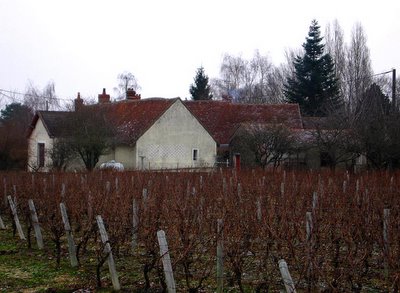 This is the hamlet (hameau) called La Renaudière. It consists of a grouping of three old houses, and one old farmhouse (une longère) that's just behind these by about 100 meters. One house is occupied by a 90-year-old woman who lives alone. Another is home to an 80-year-old woman who lives with her daughter and grand-daughter. The third is lived in by a couple in their late 50s, who have nicely restored the place. The fourth old house is our neighbors' country house, where they spend only summers.
This is the hamlet (hameau) called La Renaudière. It consists of a grouping of three old houses, and one old farmhouse (une longère) that's just behind these by about 100 meters. One house is occupied by a 90-year-old woman who lives alone. Another is home to an 80-year-old woman who lives with her daughter and grand-daughter. The third is lived in by a couple in their late 50s, who have nicely restored the place. The fourth old house is our neighbors' country house, where they spend only summers. Looking back toward La Renaudière from out in the vineyards, you can barely see the grouping of houses. Ours is a very recent addition to the neighborhood, having been built in the late 1960s. The Renaudie vineyards are extensive. Living on the edge of them gives us the impression that we have all the space in the world out our back gate.
Looking back toward La Renaudière from out in the vineyards, you can barely see the grouping of houses. Ours is a very recent addition to the neighborhood, having been built in the late 1960s. The Renaudie vineyards are extensive. Living on the edge of them gives us the impression that we have all the space in the world out our back gate. This was a stand of oaks and pines between two fields of grape vines. Then last year some men came and cut down all the oaks. I assume the wood was to be used as firewoood. The pines are left standing. Somehow this picture reminds me of the coast of North Carolina, where I grew up.
This was a stand of oaks and pines between two fields of grape vines. Then last year some men came and cut down all the oaks. I assume the wood was to be used as firewoood. The pines are left standing. Somehow this picture reminds me of the coast of North Carolina, where I grew up. This is the gravel road that runs through the Renaudie vineyards and where we often walk the dog. It's fairly well maintained and I also drive on it often on my way to the supermarket. It's less than a mile long and connects to a paved road out back, and that road is marked as the route touristique that winds through the Touraine vineyards. Out in the vineyards not far from us are a bakery that has wood-fired ovens and makes really good bread and croissants, and a goat farm that sells cheese and operates as a restaurant and inn.
This is the gravel road that runs through the Renaudie vineyards and where we often walk the dog. It's fairly well maintained and I also drive on it often on my way to the supermarket. It's less than a mile long and connects to a paved road out back, and that road is marked as the route touristique that winds through the Touraine vineyards. Out in the vineyards not far from us are a bakery that has wood-fired ovens and makes really good bread and croissants, and a goat farm that sells cheese and operates as a restaurant and inn.26 January 2006
Having formatting problems
I'm having a lot of trouble with font sizes and styles in my coq au vin topic. On my computer it was looking fine, but I just republished the topic and now some of the picture captions are wrong. They were wrong all along when Walt viewed my blog on his computer, and when I viewed in on the laptop computer we have in the living room. And now the captions are wrong on my computer, although up until a couple of minutes ago they looked fine.
I spent 3 or 4 hours on getting that coq au vin topic to upload and display. At one point, I lost all the formatting (italics, etc.) and had to start over again from scratch. Luckily, I had saved a plain text version of the file separately, in another application, and it didn't take too long to upload the pictures again -- there weren't that many of them.
The purpose of this topic is to see if I can publish a simple text blog entry without trouble. But when I select text in the blogger Create window now, it doesn't show up the way it did before. It doesn't really look selected, though I can apply font styles: bold and italic.
On another subject: It was cold and gray when we got up this morning. The low temperature was -1.7ºC (about 29ºF) and the high today was 1.6ºC (about 35ºF). It snowed lightly for a few hours around mid-day, and it was sticking on rooftops and on the gravel road out back for a while. But then it started melting. They're saying we may get a little more snow tonight and tomorrow morning.
I made a pork roast cooked in milk for lunch today. It cooked in the oven for about 3 hours. In the milk I put sauteed onions, bay leaves, garlic cloves, allspice berries, coriander berries, black peppercorns, red pepper flakes, and some curry powder. After the pork was cooked, I reduced the milk sauce a little on high heat and thickened it with a little slurry of potato starch. With the pork we had little potatoes that were browned in the oven.
OK, I'll put in one picture for this test of the blogging software. If this test works, I will assume that there is something weird with the coq au vin topic and I won't think about it any more.
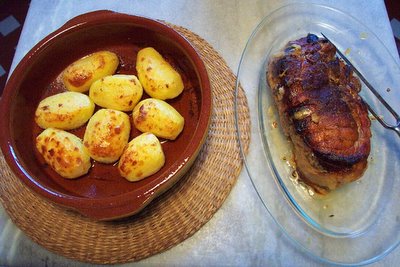
I spent 3 or 4 hours on getting that coq au vin topic to upload and display. At one point, I lost all the formatting (italics, etc.) and had to start over again from scratch. Luckily, I had saved a plain text version of the file separately, in another application, and it didn't take too long to upload the pictures again -- there weren't that many of them.
The purpose of this topic is to see if I can publish a simple text blog entry without trouble. But when I select text in the blogger Create window now, it doesn't show up the way it did before. It doesn't really look selected, though I can apply font styles: bold and italic.
On another subject: It was cold and gray when we got up this morning. The low temperature was -1.7ºC (about 29ºF) and the high today was 1.6ºC (about 35ºF). It snowed lightly for a few hours around mid-day, and it was sticking on rooftops and on the gravel road out back for a while. But then it started melting. They're saying we may get a little more snow tonight and tomorrow morning.
I made a pork roast cooked in milk for lunch today. It cooked in the oven for about 3 hours. In the milk I put sauteed onions, bay leaves, garlic cloves, allspice berries, coriander berries, black peppercorns, red pepper flakes, and some curry powder. After the pork was cooked, I reduced the milk sauce a little on high heat and thickened it with a little slurry of potato starch. With the pork we had little potatoes that were browned in the oven.
OK, I'll put in one picture for this test of the blogging software. If this test works, I will assume that there is something weird with the coq au vin topic and I won't think about it any more.

25 January 2006
Coq au vin — the real thing
Last week Intermarché advertised a special on coqs — roosters. For a few months, I had been noticing them on sale at the Saint-Aignan market on Saturdays, and I kept saying I'd like to buy one and make a real coq au vin one day. Well, the timing was right, and here was my opportunity.
 Just before Christmas there were some kids selling pony rides
Just before Christmas there were some kids selling pony rides
out in the Intermarché parking lot over in Noyers-sur-Cher.
I'd never noticed coqs in the butcher counter at Intermarché before, so I figured the advertised special must be a limited-time offer. The sale started on Tuesday, but I didn't get over to the store until Thursday. In the back of my mind, I kept thinking the coqs would all have been sold by then, and I would be out of luck. That's what has happened several times with other advertised products — ducks, for example. But this time my luck was good — there were three big roosters sitting in the butcher's refrigerated counter, and the line wasn't long at all.
The roosters were on sale for 3.20 €/kg. The butcher picked one out, put it on the scale, and then looked vaguely in my direction and said « C'est combien, les coqs ? » I pointed to the paper sign hanging over the display and told him the price. He looked at it himself. « C'est pas cher ! » I agreed it was a good price.
I also ordered two shrink-wrapped turkey legs (thigh and drumstick) for Collette's breakfasts. They were only 2.20 €/kg, and they were enormous. I was thinking, really, I could make coq au vin out of a couple of those. But no, I wanted to use a real rooster for the first time and, besides, Walt likes the white meat on the bird. There's no white meat on a turkey leg.
 This coq was on sale at the market in Saint-Aignan on New Year's Eve.
This coq was on sale at the market in Saint-Aignan on New Year's Eve.
As is customary, it is being sold with the head and feet attached.
It's the same price as what I paid at Intermarché, but the
supermarket bird was all prepared for cooking.
The Intermarché rooster I bought weighed 3.47 kg — that's just short of 8 lbs. It was a big beast. The label stuck on the breast said Coq à mijoter — stewing rooster. In North Carolina, we used to get stewing hens. They needed to be cooked for a long time, because they were tough old birds. A couple of times here in Saint-Aignan, I've bought what I thought was a chicken (un poulet) only to realize when I got it home that it was a hen (une poule). A poule requires long, slow cooking. Otherwise, it's tough.
The Joy of Cooking (1997 edition) mentions stewing hens and other large chickens that are called roasters, which weigh 5 to 7 pounds. But there's nothing in the book specifically about roosters or coqs. About stewing hens, the book says that the usual treatment is to stew them slowly for a long time but, it says, "no matter how they are cooked, the meat is dry and distinctly stringy." That's not a ringing endorsement.
 This is the coq I bought at Intermarché.
This is the coq I bought at Intermarché.
The longer knife in the picture measures 10½ inches (26 cm).
That might give you some idea of the size of the bird.
Ginette Mathiot, in Je sais cuisiner (1970), has a recipe for coq au vin that uses a jeune chapon — a young capon — weighing 1.5 kg. A capon is a rooster that has been castrated and fattened up. My rooster was not a capon — capons are much more expensive — and it weighed more than twice what Mathiot's young capon weighed. When I looked up coq au vin in another favorite French cookbook, Cuisine pour toute l'année (1969, 1991) by Monique Maine, I found a recipe that called for a jeune coq, with no indication of weight.
I figured the 8 lb. rooster I had bought was not all that young, especially since, according to the label, it needed to be stewed.
Then I went to the Larousse Gastronomique (1938), one of the bibles of French cooking. I looked up coq, and what I read was this: « Synonyme culinaire du poulet dans certains apprêts : coq au vin, coq en pâte, etc. » — "A culinary synonym for chicken in certain recipes..." The recipe for coq au vin given just below that explanation, and which is said to be based on an ancient recipe (d'après une recette ancienne), says to "cut into six pieces a young chicken from Limagne." Now I knew that I hadn't bought a jeune poulet de Limagne, whatever and wherever that is. (Turns out it's a place in the Auvergne...) Here's a site giving some history and recipes for coq au vin.
What I had was an old stewing rooster. If the Joy of Cooking's warning about stewing hens applied, it was going to be dry and "distinctly stringy" no matter how long I cooked it. This wasn't working out as planned. Even Julia Child's recipes, in the books of hers that I have on my shelves, call for using a frying chicken to make coq au vin. Frying chickens are young birds.
 The coq cut into seven pieces. I went on to cut the breast in half,
The coq cut into seven pieces. I went on to cut the breast in half,
which I managed to do with a big Chinese meat cleaver.
I made stock with the back and the wing tips.
I didn't see any alternative except to go ahead with my plan anyway. I went to the supermarket on Saturday and bought two bottles of inexpensive red wine from Cahors. I wanted a wine that was strong and full-bodied, and that would stand up to the tough bird I was cooking. Cahors wine used to be called vin noir — black wine — because it was so dark in color compared to the wine made in the nearby Bordeaux area. Bordeaux red wines are made from Cabernet Sauvignon and Merlot grapes, whereas Cahors wines are made with what are widely known as Malbec grapes -- known in the Loire Valley as Côt, and in Cahors itself as Auxerrois. Around Saint-Aignan, people serve Côt/Malbec wines with hearty dishes like venison stew and bœuf bourguignon.
I also bought about 400 grams of smoked slab bacon — poitrine fumée — which I cut up into big chunks. I like to cook the smoked meat in the wine sauce along with the poultry, because I like that flavor. Many recipes for coq au vin call for cooking the chicken in the wine with onions and carrots and then serving the smoked pork bacon, sauteed separately, as a garnish, along with some sauteed pearl onions and sauteed mushrooms.
I'm still working on using up that 5 kg (11 lb.) bag on onions I bought at Ed a couple of weeks ago, so I decided I could do without the pearl onions. I started by slicing up 5 or 6 medium onions and cutting a couple of big carrots into chunks. I sauteed all that in some duck fat (yes, I still have some in the refrigerator, but I could have instead used butter or vegetable oil or a combination of the two). Then I took the vegetables out of the pan and put in the pieces of smoked bacon to give them a good sauté.
Meanwhile, I cut the coq up into eight pieces — two wings, two drumsticks, two thighs, and two breast pieces. When the pork was cooked, I put it in the bowl with the reserved onions and carrots and then I put half the chicken pieces in the fat to brown at a fairly high temperature. It was kind of messy, but I used a big high-sided pot for the browning to keep fat from spattering all over the kitchen. When the first batch was done, I put in the second batch of rooster pieces and browned those. I made stock using the leftover rooster back and the two wing tips.
 The rooster pieces after they have cooked for about two hours
The rooster pieces after they have cooked for about two hours
in the wine sauce with bacon, vegetables, and seasonings.
I did all this on Saturday afternoon in preparation for Sunday afternoon's dinner. When all the rooster pieces were browned, I put everything back in the pot — onions, carrots, bacon — and poured about a bottle and a half of the dark Cahors wine over all of it (I had to save some out to taste). I added a good pint or more of the rooster broth I had made, along with enough water to cover everything, so that it was bathing in liquid. I threw in a couple of big garlic cloves and three good-sized bay leaves (off the tree in the back yard — what a luxury to have those bay leaves for making this kind of dish). A grind of black pepper, a big pinch of dried thyme, and it was ready to cook. I put it on a burner at medium heat and let it simmer for about two hours.
It was getting to be time to go to bed. I transferred the rooster pieces into a big baking dish and poured over them as much of the sauce as would fit. The whole thing would sit overnight and then cook for another few hours in oven in the morning. Problem was, the dish wouldn't fit in the refrigerator. So I had to cover it with a lid and take it down to set in on the cold stone floor on the front porch, which is glassed in but not heated. It sat there overnight. I put the rest of the sauce in a bowl in the fridge.
 The rooster pieces after the first cooking and the quart
The rooster pieces after the first cooking and the quart
of stock I made with the back and wing tips.
The next morning I got up and turned the oven on at 8:00. I went downstairs and fetched the baking dish. I put it directly into the oven, which was getting hot. After an hour or so, I turned it down to medium. I checked to see if the liquid in the dish was boiling, and it was. Then I turned it down again and let it cook at a fairly low temperature until noon.
While it was simmering in the oven, I washed and sliced a pound of white button mushrooms, and then I sauteed them in butter. When they were cooked I added them to the dish in the oven, along with some of the sauce from the fridge to make up for what had cooked away, and then I let all that simmer for another half hour. I figured that would be enough simmering to tenderize the rooster — or at least I hoped it would be tender, despite the opinions of the doubting Thomas who wrote the Joy of Cooking.
And was it ever good! It was the best coq au vin I've ever made. It was definitely not a mistake to buy that big bird. The bacon chunks were big enough so that they did not melt into the sauce. If you cut up and used sliced American bacon in the recipe, you wouldn't find the bacon pieces at all after such a long cooking. Get slab bacon if you can find it. The onions had pretty much disappeared, but the chunks of carrot were still intact.
We had the coq au vin for lunch with pasta (macaroni) and a big green salad. The wine sauce was salty, but not overly so. That was the bacon. We started by eating a piece of breast meat. It was tender and succulent — not at all dry or stringy. Then we tried a piece of thigh meat — it was even better, tender and moist, as I suspected it would be.
I'm sorry I didn't take any pictures of the finished dish, but sometimes you're just too busy eating to feel like fiddling with a camera.
Today we had coq au vin for the third day in a row at lunchtime, without being tired of it. Yesterday, we made French fries to serve with it — that was a treat. Today we had it with the rest of the macaroni. And a big green salad each time. I should point out that those three meals didn't include the drumsticks, the wings, and a good portion of the sauce containing bacon, carrots, onions, mushrooms, etc., which we put in a container in the freezer for later. That'll make at least one more big meal, if not two.
Next time, I'll buy one of those coqs they sell at the Saint-Aignan market. I'm sure it will be just as good, if not better. I'll be able to add the head and the feet to the stockpot.
 Just before Christmas there were some kids selling pony rides
Just before Christmas there were some kids selling pony ridesout in the Intermarché parking lot over in Noyers-sur-Cher.
I'd never noticed coqs in the butcher counter at Intermarché before, so I figured the advertised special must be a limited-time offer. The sale started on Tuesday, but I didn't get over to the store until Thursday. In the back of my mind, I kept thinking the coqs would all have been sold by then, and I would be out of luck. That's what has happened several times with other advertised products — ducks, for example. But this time my luck was good — there were three big roosters sitting in the butcher's refrigerated counter, and the line wasn't long at all.
The roosters were on sale for 3.20 €/kg. The butcher picked one out, put it on the scale, and then looked vaguely in my direction and said « C'est combien, les coqs ? » I pointed to the paper sign hanging over the display and told him the price. He looked at it himself. « C'est pas cher ! » I agreed it was a good price.
I also ordered two shrink-wrapped turkey legs (thigh and drumstick) for Collette's breakfasts. They were only 2.20 €/kg, and they were enormous. I was thinking, really, I could make coq au vin out of a couple of those. But no, I wanted to use a real rooster for the first time and, besides, Walt likes the white meat on the bird. There's no white meat on a turkey leg.
 This coq was on sale at the market in Saint-Aignan on New Year's Eve.
This coq was on sale at the market in Saint-Aignan on New Year's Eve.As is customary, it is being sold with the head and feet attached.
It's the same price as what I paid at Intermarché, but the
supermarket bird was all prepared for cooking.
The Intermarché rooster I bought weighed 3.47 kg — that's just short of 8 lbs. It was a big beast. The label stuck on the breast said Coq à mijoter — stewing rooster. In North Carolina, we used to get stewing hens. They needed to be cooked for a long time, because they were tough old birds. A couple of times here in Saint-Aignan, I've bought what I thought was a chicken (un poulet) only to realize when I got it home that it was a hen (une poule). A poule requires long, slow cooking. Otherwise, it's tough.
The Joy of Cooking (1997 edition) mentions stewing hens and other large chickens that are called roasters, which weigh 5 to 7 pounds. But there's nothing in the book specifically about roosters or coqs. About stewing hens, the book says that the usual treatment is to stew them slowly for a long time but, it says, "no matter how they are cooked, the meat is dry and distinctly stringy." That's not a ringing endorsement.
 This is the coq I bought at Intermarché.
This is the coq I bought at Intermarché.The longer knife in the picture measures 10½ inches (26 cm).
That might give you some idea of the size of the bird.
Ginette Mathiot, in Je sais cuisiner (1970), has a recipe for coq au vin that uses a jeune chapon — a young capon — weighing 1.5 kg. A capon is a rooster that has been castrated and fattened up. My rooster was not a capon — capons are much more expensive — and it weighed more than twice what Mathiot's young capon weighed. When I looked up coq au vin in another favorite French cookbook, Cuisine pour toute l'année (1969, 1991) by Monique Maine, I found a recipe that called for a jeune coq, with no indication of weight.
I figured the 8 lb. rooster I had bought was not all that young, especially since, according to the label, it needed to be stewed.
Then I went to the Larousse Gastronomique (1938), one of the bibles of French cooking. I looked up coq, and what I read was this: « Synonyme culinaire du poulet dans certains apprêts : coq au vin, coq en pâte, etc. » — "A culinary synonym for chicken in certain recipes..." The recipe for coq au vin given just below that explanation, and which is said to be based on an ancient recipe (d'après une recette ancienne), says to "cut into six pieces a young chicken from Limagne." Now I knew that I hadn't bought a jeune poulet de Limagne, whatever and wherever that is. (Turns out it's a place in the Auvergne...) Here's a site giving some history and recipes for coq au vin.
What I had was an old stewing rooster. If the Joy of Cooking's warning about stewing hens applied, it was going to be dry and "distinctly stringy" no matter how long I cooked it. This wasn't working out as planned. Even Julia Child's recipes, in the books of hers that I have on my shelves, call for using a frying chicken to make coq au vin. Frying chickens are young birds.
 The coq cut into seven pieces. I went on to cut the breast in half,
The coq cut into seven pieces. I went on to cut the breast in half,which I managed to do with a big Chinese meat cleaver.
I made stock with the back and the wing tips.
I didn't see any alternative except to go ahead with my plan anyway. I went to the supermarket on Saturday and bought two bottles of inexpensive red wine from Cahors. I wanted a wine that was strong and full-bodied, and that would stand up to the tough bird I was cooking. Cahors wine used to be called vin noir — black wine — because it was so dark in color compared to the wine made in the nearby Bordeaux area. Bordeaux red wines are made from Cabernet Sauvignon and Merlot grapes, whereas Cahors wines are made with what are widely known as Malbec grapes -- known in the Loire Valley as Côt, and in Cahors itself as Auxerrois. Around Saint-Aignan, people serve Côt/Malbec wines with hearty dishes like venison stew and bœuf bourguignon.
I also bought about 400 grams of smoked slab bacon — poitrine fumée — which I cut up into big chunks. I like to cook the smoked meat in the wine sauce along with the poultry, because I like that flavor. Many recipes for coq au vin call for cooking the chicken in the wine with onions and carrots and then serving the smoked pork bacon, sauteed separately, as a garnish, along with some sauteed pearl onions and sauteed mushrooms.
I'm still working on using up that 5 kg (11 lb.) bag on onions I bought at Ed a couple of weeks ago, so I decided I could do without the pearl onions. I started by slicing up 5 or 6 medium onions and cutting a couple of big carrots into chunks. I sauteed all that in some duck fat (yes, I still have some in the refrigerator, but I could have instead used butter or vegetable oil or a combination of the two). Then I took the vegetables out of the pan and put in the pieces of smoked bacon to give them a good sauté.
Meanwhile, I cut the coq up into eight pieces — two wings, two drumsticks, two thighs, and two breast pieces. When the pork was cooked, I put it in the bowl with the reserved onions and carrots and then I put half the chicken pieces in the fat to brown at a fairly high temperature. It was kind of messy, but I used a big high-sided pot for the browning to keep fat from spattering all over the kitchen. When the first batch was done, I put in the second batch of rooster pieces and browned those. I made stock using the leftover rooster back and the two wing tips.
 The rooster pieces after they have cooked for about two hours
The rooster pieces after they have cooked for about two hoursin the wine sauce with bacon, vegetables, and seasonings.
I did all this on Saturday afternoon in preparation for Sunday afternoon's dinner. When all the rooster pieces were browned, I put everything back in the pot — onions, carrots, bacon — and poured about a bottle and a half of the dark Cahors wine over all of it (I had to save some out to taste). I added a good pint or more of the rooster broth I had made, along with enough water to cover everything, so that it was bathing in liquid. I threw in a couple of big garlic cloves and three good-sized bay leaves (off the tree in the back yard — what a luxury to have those bay leaves for making this kind of dish). A grind of black pepper, a big pinch of dried thyme, and it was ready to cook. I put it on a burner at medium heat and let it simmer for about two hours.
It was getting to be time to go to bed. I transferred the rooster pieces into a big baking dish and poured over them as much of the sauce as would fit. The whole thing would sit overnight and then cook for another few hours in oven in the morning. Problem was, the dish wouldn't fit in the refrigerator. So I had to cover it with a lid and take it down to set in on the cold stone floor on the front porch, which is glassed in but not heated. It sat there overnight. I put the rest of the sauce in a bowl in the fridge.
 The rooster pieces after the first cooking and the quart
The rooster pieces after the first cooking and the quartof stock I made with the back and wing tips.
The next morning I got up and turned the oven on at 8:00. I went downstairs and fetched the baking dish. I put it directly into the oven, which was getting hot. After an hour or so, I turned it down to medium. I checked to see if the liquid in the dish was boiling, and it was. Then I turned it down again and let it cook at a fairly low temperature until noon.
While it was simmering in the oven, I washed and sliced a pound of white button mushrooms, and then I sauteed them in butter. When they were cooked I added them to the dish in the oven, along with some of the sauce from the fridge to make up for what had cooked away, and then I let all that simmer for another half hour. I figured that would be enough simmering to tenderize the rooster — or at least I hoped it would be tender, despite the opinions of the doubting Thomas who wrote the Joy of Cooking.
And was it ever good! It was the best coq au vin I've ever made. It was definitely not a mistake to buy that big bird. The bacon chunks were big enough so that they did not melt into the sauce. If you cut up and used sliced American bacon in the recipe, you wouldn't find the bacon pieces at all after such a long cooking. Get slab bacon if you can find it. The onions had pretty much disappeared, but the chunks of carrot were still intact.
We had the coq au vin for lunch with pasta (macaroni) and a big green salad. The wine sauce was salty, but not overly so. That was the bacon. We started by eating a piece of breast meat. It was tender and succulent — not at all dry or stringy. Then we tried a piece of thigh meat — it was even better, tender and moist, as I suspected it would be.
I'm sorry I didn't take any pictures of the finished dish, but sometimes you're just too busy eating to feel like fiddling with a camera.
Today we had coq au vin for the third day in a row at lunchtime, without being tired of it. Yesterday, we made French fries to serve with it — that was a treat. Today we had it with the rest of the macaroni. And a big green salad each time. I should point out that those three meals didn't include the drumsticks, the wings, and a good portion of the sauce containing bacon, carrots, onions, mushrooms, etc., which we put in a container in the freezer for later. That'll make at least one more big meal, if not two.
Next time, I'll buy one of those coqs they sell at the Saint-Aignan market. I'm sure it will be just as good, if not better. I'll be able to add the head and the feet to the stockpot.
23 January 2006
Signs of Paris
It's ironic. Walt and I used to spend more time in Paris when we lived in San Francisco than we do now that we live in the Loire Valley. But the idea of wandering through the streets of the city is still so attractive. Here in the country, the trees are bare of leaves, the sky is leaden gray, and there aren't any people around besides the hunters on Sundays and the 5 or 6 people who work in the vineyards during the week. There certainly aren't any bright city lights.
When we lived in SF, we could travel to the extent our time off from work would allow. We could arrange for somebody to watch the house and the dog while we were in France (because we seldom went anywhere else). Nowadays, our budget is more restrictive. We haven't found anybody to watch the poor old dog. So we stay close to home. Of course, we are in France, so many of the things we enjoyed in Paris -- markets and restaurants, mainly -- we also have here.
Looking at the pictures of Paris, many taken in wintertime, is good therapy, though, on days when the winter weather is dull. For example:
 The Olympia is one of the most famous theaters (what the French call "music halls," using the English term) in Paris. Jacques Brel became famous singing here in the 1960s. For French singers (and others -- I saw Simon and Garfunkel at the Olympia in 1970, if you can believe that), performing at the Olympia is a kind of consacration. It's a sign you've made it.
The Olympia is one of the most famous theaters (what the French call "music halls," using the English term) in Paris. Jacques Brel became famous singing here in the 1960s. For French singers (and others -- I saw Simon and Garfunkel at the Olympia in 1970, if you can believe that), performing at the Olympia is a kind of consacration. It's a sign you've made it.
In January 2000, Walt and I flew to Paris for a long weekend to see and hear Véronique Sanson perform. That's how ample our resources were then. It's a long story for a very short trip. We had happened to drive through Las Vegas in September 1999. The Paris-Las Vegas resort had just opened, and a French singer named Liane Foly was listed on the marquee as performing on Columbus Day weekend in October. We thought it would be fun to go see her. When we got back to SF, we made calls to the hotel and the airlines. The hotel wanted $300 a night for a room. The airlines wanted $500 round-trip for the one-hour flight, because it was a holiday weekend. So the trip was going to cost us at least $1500 if we stayed two nights, plus food, drink, and other expenses. That was too much, for what it was.
Coincidentally, I learned that Véronique Sanson was doing a "come-back" appearance at the Olympia in January after a long hiatus from performing. "Let's go to Paris instead of Las Vegas," I said to Walt. It turned out that we got two round trips on Air France for about $500 apiece, and I found an apartment to rent for three nights at $75 a night. That was half-price -- a January, off-season special. And it was an apartment we had rented before, so we knew what we were getting. We went.
Véronique Sanson is a woman who is exactly my age. I've been listening to her songs since the mid-1970s. I "grew up" -- it was my second childhood because I was in my 20s living in Paris -- with her music in the background (along with Souchon's, Voulzy's, LeForestier's, and France Gall's, singing Michel Berger's songs). I had never seen her on stage before. She lived in America for many years, married to Stephen Stills of Crosby, Stills, Nash & Young fame. It was worth it to me to fly to Paris for the event.
On that January weekend trip, we had dinner at midnight in a restaurant not too far from the old Paris opera house, across the street from the Bourse (the Stock Exchange). The place was packed and noisy, and the food was good. I'm not a night owl, so I was suprised to see so many people in a restaurant so late at night.
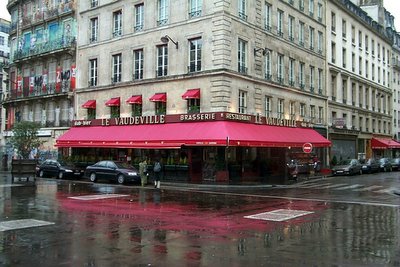 I took this picture of the restaurant, Le Vaudeville, during that same weekend. In both these pictures, you can see the red lights and awnings reflecting their color off wet pavement. That's Paris -- it's actually at least as pretty in the rain as it is when the sun is shining. Out here in the country, we don't even have street lights, much less neon signs and red awnings.
I took this picture of the restaurant, Le Vaudeville, during that same weekend. In both these pictures, you can see the red lights and awnings reflecting their color off wet pavement. That's Paris -- it's actually at least as pretty in the rain as it is when the sun is shining. Out here in the country, we don't even have street lights, much less neon signs and red awnings.
We spent that weekend in January 2000 just walking around the city, stopping in cafés and restaurants to warm up and dry off when we needed to.
 I thought this café-tabac had an especially appropriate name. It's not far from the place de la Bastille, on the avenue Henri IV.
I thought this café-tabac had an especially appropriate name. It's not far from the place de la Bastille, on the avenue Henri IV.
 Here's another place, one where we used to go for dinner back in the early 1980s, when we first met. It's called Les Noces de Jeannette, Jeannette's Wedding. We haven't been back since then, partly because I heard the place had begun specializing in feeding busloads of tourists from Japan and eastern Europe. Maybe I need to read about it and see if it's worth a return visit. Again, red light reflects off wet pavement.
Here's another place, one where we used to go for dinner back in the early 1980s, when we first met. It's called Les Noces de Jeannette, Jeannette's Wedding. We haven't been back since then, partly because I heard the place had begun specializing in feeding busloads of tourists from Japan and eastern Europe. Maybe I need to read about it and see if it's worth a return visit. Again, red light reflects off wet pavement.
Here are a few more random pictures of Paris street scenes.
 "Le Chien qui Fume" (The Smoking Dog) is a café-restaurant on the boulevard Montparnasse. That green sign represents a métro ticket -- you can buy subway tickets here.
"Le Chien qui Fume" (The Smoking Dog) is a café-restaurant on the boulevard Montparnasse. That green sign represents a métro ticket -- you can buy subway tickets here.
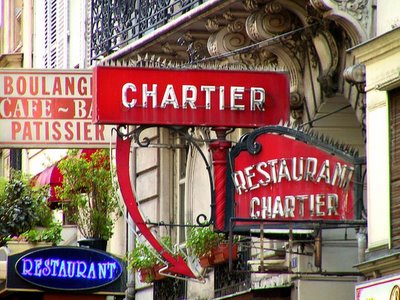 The Restaurant Chartier is a Paris institution. It's just off the Grands Boulevards, not far from the Opéra Garnier, at Métro Grands Boulevards. It's a bustling, crowded Paris bistrot with the most extensive menu you can imagine. You can order the day's specials or any of a hundred dishes off the standard menu. There's usually a line out the front door. If there are two of you, you are likely to be seated at a table with two other people. The tables have paper tablecloths on them, and the waiter writes down you order on the paper so he can keep track of it. Prices are very reasonable, and the food is good and honest (don't expect too much!).
The Restaurant Chartier is a Paris institution. It's just off the Grands Boulevards, not far from the Opéra Garnier, at Métro Grands Boulevards. It's a bustling, crowded Paris bistrot with the most extensive menu you can imagine. You can order the day's specials or any of a hundred dishes off the standard menu. There's usually a line out the front door. If there are two of you, you are likely to be seated at a table with two other people. The tables have paper tablecloths on them, and the waiter writes down you order on the paper so he can keep track of it. Prices are very reasonable, and the food is good and honest (don't expect too much!).
I took my mother and my 15-year-old niece to Chartier for lunch in the summer of 1997. We had no problem finding just what we wanted to eat -- there's something for every palate. But my niece ordered un épis de maïs -- corn on the cob. That was a mistake. It was feed corn, and it had been cooked for a long time. Still, it was too tough to eat. Don't order corn in France.
The young waiter was quite taken with my niece. He gave us very attentive service and flirted with her. Over the next few days she kept saying she wanted to go back to Chartier for another lunch. We returned three or four days later, and my niece was disappointed when we were seated in a section that was served by a different waiter. Across the big room, we saw the one she had wanted to see again. And he saw us. He found the time to come over and say hello, and he actually kissed my niece's hand in greeting her. I thought she was going to go into a swoon (c'est à dire tomber en pâmoison). It was a very nice experience for her.
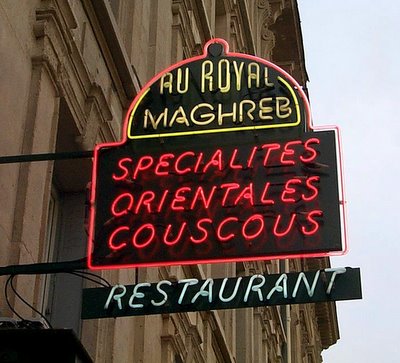 Another thing we miss out here in the country -- couscous. It's a big North African stew of vegetables and meats (chicken, lamb) served with spicy merguez sausages and couscous grain. We have to make our own, these days.
Another thing we miss out here in the country -- couscous. It's a big North African stew of vegetables and meats (chicken, lamb) served with spicy merguez sausages and couscous grain. We have to make our own, these days.
 I miss the warmth and the good food in café-brasserie-bar establishments like this one on the rue Saint-Dominique in the 7th.
I miss the warmth and the good food in café-brasserie-bar establishments like this one on the rue Saint-Dominique in the 7th.
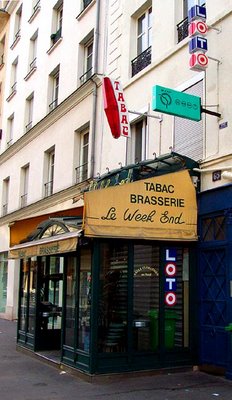 Another place called Le Week End, this one on the rue de Sèvres in the 7th. It's closed for the day and the metal shutters inside the veranda are pulled down.
Another place called Le Week End, this one on the rue de Sèvres in the 7th. It's closed for the day and the metal shutters inside the veranda are pulled down.
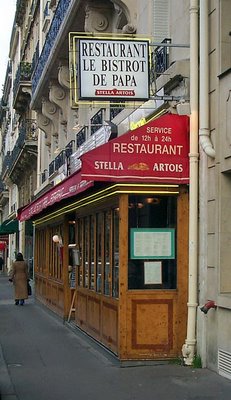 The Bistrot de Papa restaurant, near the Ecole Militaire métro stop, is a typical-looking place with a wooden front and big windows.
The Bistrot de Papa restaurant, near the Ecole Militaire métro stop, is a typical-looking place with a wooden front and big windows.
 The least expensive wine list in France, the sign says. It's at least worth checking out, don't you think?
The least expensive wine list in France, the sign says. It's at least worth checking out, don't you think?
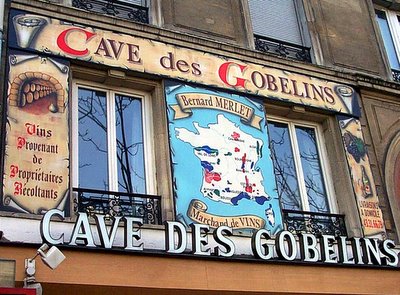 Here's the fancy façade of a cave, a wine shop, in the 13th arrondissement.
Here's the fancy façade of a cave, a wine shop, in the 13th arrondissement.
That's my therapy for the day, which is gray and cold. They're predicting snow for later in the week. Time to hunker down and finish that coq au vin I made over the weekend. More about that later...
When we lived in SF, we could travel to the extent our time off from work would allow. We could arrange for somebody to watch the house and the dog while we were in France (because we seldom went anywhere else). Nowadays, our budget is more restrictive. We haven't found anybody to watch the poor old dog. So we stay close to home. Of course, we are in France, so many of the things we enjoyed in Paris -- markets and restaurants, mainly -- we also have here.
Looking at the pictures of Paris, many taken in wintertime, is good therapy, though, on days when the winter weather is dull. For example:
 The Olympia is one of the most famous theaters (what the French call "music halls," using the English term) in Paris. Jacques Brel became famous singing here in the 1960s. For French singers (and others -- I saw Simon and Garfunkel at the Olympia in 1970, if you can believe that), performing at the Olympia is a kind of consacration. It's a sign you've made it.
The Olympia is one of the most famous theaters (what the French call "music halls," using the English term) in Paris. Jacques Brel became famous singing here in the 1960s. For French singers (and others -- I saw Simon and Garfunkel at the Olympia in 1970, if you can believe that), performing at the Olympia is a kind of consacration. It's a sign you've made it.In January 2000, Walt and I flew to Paris for a long weekend to see and hear Véronique Sanson perform. That's how ample our resources were then. It's a long story for a very short trip. We had happened to drive through Las Vegas in September 1999. The Paris-Las Vegas resort had just opened, and a French singer named Liane Foly was listed on the marquee as performing on Columbus Day weekend in October. We thought it would be fun to go see her. When we got back to SF, we made calls to the hotel and the airlines. The hotel wanted $300 a night for a room. The airlines wanted $500 round-trip for the one-hour flight, because it was a holiday weekend. So the trip was going to cost us at least $1500 if we stayed two nights, plus food, drink, and other expenses. That was too much, for what it was.
Coincidentally, I learned that Véronique Sanson was doing a "come-back" appearance at the Olympia in January after a long hiatus from performing. "Let's go to Paris instead of Las Vegas," I said to Walt. It turned out that we got two round trips on Air France for about $500 apiece, and I found an apartment to rent for three nights at $75 a night. That was half-price -- a January, off-season special. And it was an apartment we had rented before, so we knew what we were getting. We went.
Véronique Sanson is a woman who is exactly my age. I've been listening to her songs since the mid-1970s. I "grew up" -- it was my second childhood because I was in my 20s living in Paris -- with her music in the background (along with Souchon's, Voulzy's, LeForestier's, and France Gall's, singing Michel Berger's songs). I had never seen her on stage before. She lived in America for many years, married to Stephen Stills of Crosby, Stills, Nash & Young fame. It was worth it to me to fly to Paris for the event.
On that January weekend trip, we had dinner at midnight in a restaurant not too far from the old Paris opera house, across the street from the Bourse (the Stock Exchange). The place was packed and noisy, and the food was good. I'm not a night owl, so I was suprised to see so many people in a restaurant so late at night.
 I took this picture of the restaurant, Le Vaudeville, during that same weekend. In both these pictures, you can see the red lights and awnings reflecting their color off wet pavement. That's Paris -- it's actually at least as pretty in the rain as it is when the sun is shining. Out here in the country, we don't even have street lights, much less neon signs and red awnings.
I took this picture of the restaurant, Le Vaudeville, during that same weekend. In both these pictures, you can see the red lights and awnings reflecting their color off wet pavement. That's Paris -- it's actually at least as pretty in the rain as it is when the sun is shining. Out here in the country, we don't even have street lights, much less neon signs and red awnings.We spent that weekend in January 2000 just walking around the city, stopping in cafés and restaurants to warm up and dry off when we needed to.
 I thought this café-tabac had an especially appropriate name. It's not far from the place de la Bastille, on the avenue Henri IV.
I thought this café-tabac had an especially appropriate name. It's not far from the place de la Bastille, on the avenue Henri IV. Here's another place, one where we used to go for dinner back in the early 1980s, when we first met. It's called Les Noces de Jeannette, Jeannette's Wedding. We haven't been back since then, partly because I heard the place had begun specializing in feeding busloads of tourists from Japan and eastern Europe. Maybe I need to read about it and see if it's worth a return visit. Again, red light reflects off wet pavement.
Here's another place, one where we used to go for dinner back in the early 1980s, when we first met. It's called Les Noces de Jeannette, Jeannette's Wedding. We haven't been back since then, partly because I heard the place had begun specializing in feeding busloads of tourists from Japan and eastern Europe. Maybe I need to read about it and see if it's worth a return visit. Again, red light reflects off wet pavement.Here are a few more random pictures of Paris street scenes.
 "Le Chien qui Fume" (The Smoking Dog) is a café-restaurant on the boulevard Montparnasse. That green sign represents a métro ticket -- you can buy subway tickets here.
"Le Chien qui Fume" (The Smoking Dog) is a café-restaurant on the boulevard Montparnasse. That green sign represents a métro ticket -- you can buy subway tickets here. The Restaurant Chartier is a Paris institution. It's just off the Grands Boulevards, not far from the Opéra Garnier, at Métro Grands Boulevards. It's a bustling, crowded Paris bistrot with the most extensive menu you can imagine. You can order the day's specials or any of a hundred dishes off the standard menu. There's usually a line out the front door. If there are two of you, you are likely to be seated at a table with two other people. The tables have paper tablecloths on them, and the waiter writes down you order on the paper so he can keep track of it. Prices are very reasonable, and the food is good and honest (don't expect too much!).
The Restaurant Chartier is a Paris institution. It's just off the Grands Boulevards, not far from the Opéra Garnier, at Métro Grands Boulevards. It's a bustling, crowded Paris bistrot with the most extensive menu you can imagine. You can order the day's specials or any of a hundred dishes off the standard menu. There's usually a line out the front door. If there are two of you, you are likely to be seated at a table with two other people. The tables have paper tablecloths on them, and the waiter writes down you order on the paper so he can keep track of it. Prices are very reasonable, and the food is good and honest (don't expect too much!).I took my mother and my 15-year-old niece to Chartier for lunch in the summer of 1997. We had no problem finding just what we wanted to eat -- there's something for every palate. But my niece ordered un épis de maïs -- corn on the cob. That was a mistake. It was feed corn, and it had been cooked for a long time. Still, it was too tough to eat. Don't order corn in France.
The young waiter was quite taken with my niece. He gave us very attentive service and flirted with her. Over the next few days she kept saying she wanted to go back to Chartier for another lunch. We returned three or four days later, and my niece was disappointed when we were seated in a section that was served by a different waiter. Across the big room, we saw the one she had wanted to see again. And he saw us. He found the time to come over and say hello, and he actually kissed my niece's hand in greeting her. I thought she was going to go into a swoon (c'est à dire tomber en pâmoison). It was a very nice experience for her.
 Another thing we miss out here in the country -- couscous. It's a big North African stew of vegetables and meats (chicken, lamb) served with spicy merguez sausages and couscous grain. We have to make our own, these days.
Another thing we miss out here in the country -- couscous. It's a big North African stew of vegetables and meats (chicken, lamb) served with spicy merguez sausages and couscous grain. We have to make our own, these days. I miss the warmth and the good food in café-brasserie-bar establishments like this one on the rue Saint-Dominique in the 7th.
I miss the warmth and the good food in café-brasserie-bar establishments like this one on the rue Saint-Dominique in the 7th. Another place called Le Week End, this one on the rue de Sèvres in the 7th. It's closed for the day and the metal shutters inside the veranda are pulled down.
Another place called Le Week End, this one on the rue de Sèvres in the 7th. It's closed for the day and the metal shutters inside the veranda are pulled down. The Bistrot de Papa restaurant, near the Ecole Militaire métro stop, is a typical-looking place with a wooden front and big windows.
The Bistrot de Papa restaurant, near the Ecole Militaire métro stop, is a typical-looking place with a wooden front and big windows. The least expensive wine list in France, the sign says. It's at least worth checking out, don't you think?
The least expensive wine list in France, the sign says. It's at least worth checking out, don't you think? Here's the fancy façade of a cave, a wine shop, in the 13th arrondissement.
Here's the fancy façade of a cave, a wine shop, in the 13th arrondissement.That's my therapy for the day, which is gray and cold. They're predicting snow for later in the week. Time to hunker down and finish that coq au vin I made over the weekend. More about that later...
22 January 2006
Signs of art
A good wintertime activity: go through several years' worth of pictures you've taken, in France or elsewhere, and organize them by theme. Amazing how much time you can spend.
So here's a theme : interesting street signs seen in France.
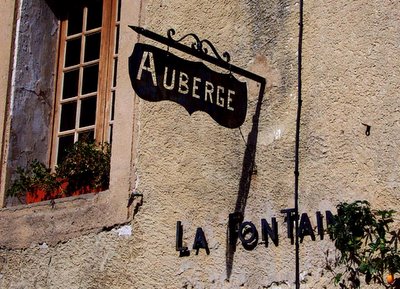 Provence. The village is Venasque, if I remember correctly, and
Provence. The village is Venasque, if I remember correctly, and
this inn is on the main square. We were there in September 2001.
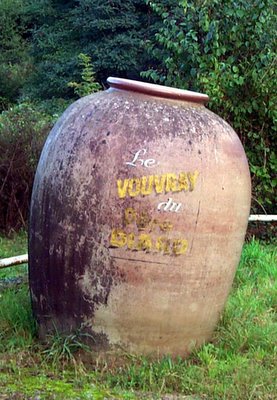 Vouvray, nears Tours in the Loire Valley. This old wine jug is in the Vallée Coquette,
Vouvray, nears Tours in the Loire Valley. This old wine jug is in the Vallée Coquette,
where several Vouvray wine producers are located.
Vouvray wines are made with chenin blanc grapes and come
in dry, semi-dry, and sweet styles — still or sparkling.
 Langeais, east of Tours in the Loire Valley. Sign at the château.
Langeais, east of Tours in the Loire Valley. Sign at the château.
 Vouvray. Moncontour is a wine château. In the 19th century,
Vouvray. Moncontour is a wine château. In the 19th century,
the novelist Balzac wanted to buy it but he could never
come up with the money. If you go, ask José about Saint-Martin...
 Montpoupon, south of Montrichard in the Cher river valley.
Montpoupon, south of Montrichard in the Cher river valley.
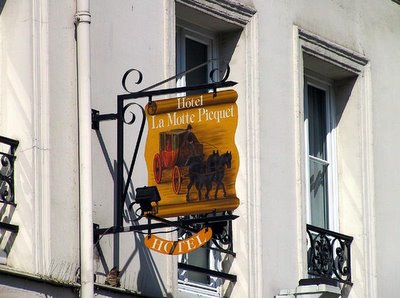 Paris, 7th arrondissement, near les Invalides and the Eiffel Tower.
Paris, 7th arrondissement, near les Invalides and the Eiffel Tower.
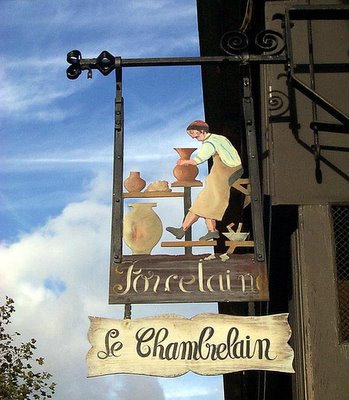 Paris, 7th arrondissement. I think this is on the avenue de la Motte-Piquet.
Paris, 7th arrondissement. I think this is on the avenue de la Motte-Piquet.
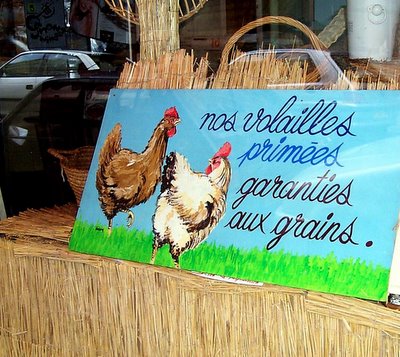 Paris, 7th arrondissement. Sign in a shop on the rue du Champs de Mars, just off
Paris, 7th arrondissement. Sign in a shop on the rue du Champs de Mars, just off
the rue Cler. It says "Our award-winning poultry is guaranteed grain-fed."
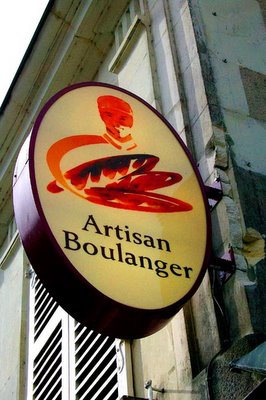 Paris, I think. A sign you see frequently in Paris and other towns in France.
Paris, I think. A sign you see frequently in Paris and other towns in France.
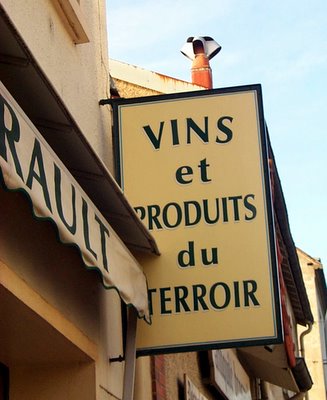 Vouvray, on the main road through town.
Vouvray, on the main road through town.
A shop specializing in wines and local products.
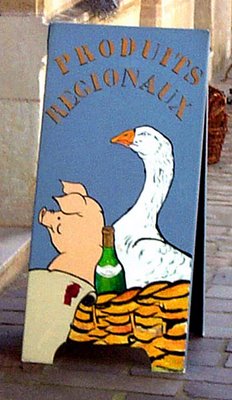 Azay-le-Rideau, west of Tours. Advertising products of the region.
Azay-le-Rideau, west of Tours. Advertising products of the region.
 Azay-le-Rideau, a gift shop.
Azay-le-Rideau, a gift shop.
 Amboise, east of Tours and 30 km (20 mi.) from Saint-Aignan.
Amboise, east of Tours and 30 km (20 mi.) from Saint-Aignan.
The sign advertises a gift shop.
Amboise, population 15,000 or so, is a major tourist stop on the Loire River.
It has its own château, along with the house where Leonardo da Vinci
lived out the last few years of his life.
 Amboise, a real estate office sign. The British "invasion" has started in our region,
Amboise, a real estate office sign. The British "invasion" has started in our region,
by the way. We have a new British friend who is getting ready to open
a realty office in Montrichard, 10 miles south of Amboise.
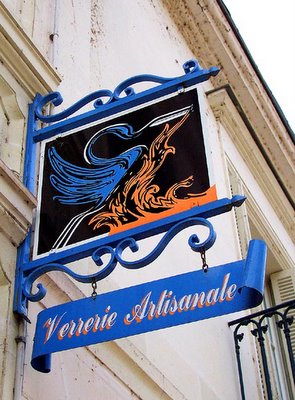 Amboise, a shop that sells locally made glass items.
Amboise, a shop that sells locally made glass items.
Amboise is one of the nicest towns on the Loire river.
Other sites, including the Vouvray and Montlouis wine areas
and the châteaux at Chenonceaux, Blois, Chaumont-sur-Loire,
and Chambord, are close by.
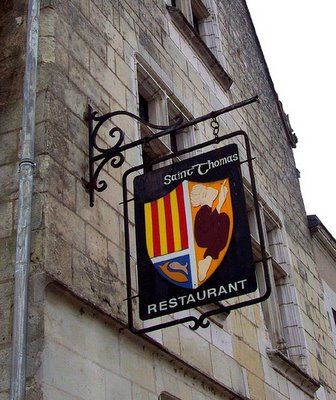 Amboise, a restaurant sign. There are dozens of restaurants in the town.
Amboise, a restaurant sign. There are dozens of restaurants in the town.
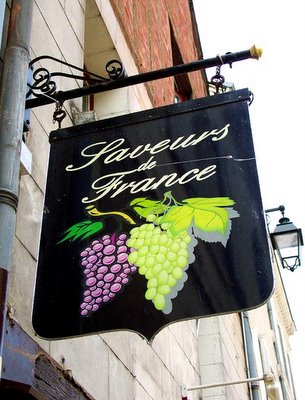 Amboise, a shop selling luxury grocery items.
Amboise, a shop selling luxury grocery items.
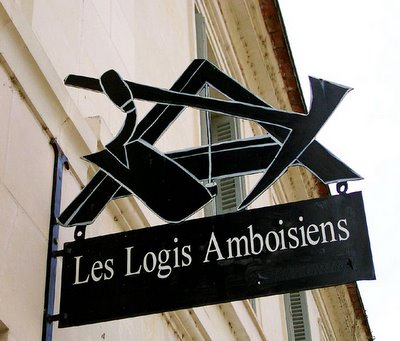 Amboise, a builder's office, I believe.
Amboise, a builder's office, I believe.
 Amboise, a good restaurant in the street below the château.
Amboise, a good restaurant in the street below the château.
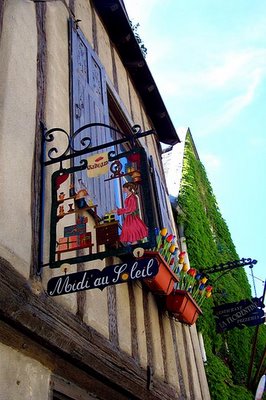 Amboise, the Midi au Soleil gift shop sign with window boxes
Amboise, the Midi au Soleil gift shop sign with window boxes
of wooden tulips on the front of the old building.
So here's a theme : interesting street signs seen in France.
 Provence. The village is Venasque, if I remember correctly, and
Provence. The village is Venasque, if I remember correctly, andthis inn is on the main square. We were there in September 2001.
 Vouvray, nears Tours in the Loire Valley. This old wine jug is in the Vallée Coquette,
Vouvray, nears Tours in the Loire Valley. This old wine jug is in the Vallée Coquette,where several Vouvray wine producers are located.
Vouvray wines are made with chenin blanc grapes and come
in dry, semi-dry, and sweet styles — still or sparkling.
 Langeais, east of Tours in the Loire Valley. Sign at the château.
Langeais, east of Tours in the Loire Valley. Sign at the château. Vouvray. Moncontour is a wine château. In the 19th century,
Vouvray. Moncontour is a wine château. In the 19th century,the novelist Balzac wanted to buy it but he could never
come up with the money. If you go, ask José about Saint-Martin...
 Montpoupon, south of Montrichard in the Cher river valley.
Montpoupon, south of Montrichard in the Cher river valley. Paris, 7th arrondissement, near les Invalides and the Eiffel Tower.
Paris, 7th arrondissement, near les Invalides and the Eiffel Tower. Paris, 7th arrondissement. I think this is on the avenue de la Motte-Piquet.
Paris, 7th arrondissement. I think this is on the avenue de la Motte-Piquet. Paris, 7th arrondissement. Sign in a shop on the rue du Champs de Mars, just off
Paris, 7th arrondissement. Sign in a shop on the rue du Champs de Mars, just offthe rue Cler. It says "Our award-winning poultry is guaranteed grain-fed."
 Paris, I think. A sign you see frequently in Paris and other towns in France.
Paris, I think. A sign you see frequently in Paris and other towns in France. Vouvray, on the main road through town.
Vouvray, on the main road through town.A shop specializing in wines and local products.
 Azay-le-Rideau, west of Tours. Advertising products of the region.
Azay-le-Rideau, west of Tours. Advertising products of the region. Azay-le-Rideau, a gift shop.
Azay-le-Rideau, a gift shop. Amboise, east of Tours and 30 km (20 mi.) from Saint-Aignan.
Amboise, east of Tours and 30 km (20 mi.) from Saint-Aignan.The sign advertises a gift shop.
Amboise, population 15,000 or so, is a major tourist stop on the Loire River.
It has its own château, along with the house where Leonardo da Vinci
lived out the last few years of his life.
 Amboise, a real estate office sign. The British "invasion" has started in our region,
Amboise, a real estate office sign. The British "invasion" has started in our region,by the way. We have a new British friend who is getting ready to open
a realty office in Montrichard, 10 miles south of Amboise.
 Amboise, a shop that sells locally made glass items.
Amboise, a shop that sells locally made glass items.Amboise is one of the nicest towns on the Loire river.
Other sites, including the Vouvray and Montlouis wine areas
and the châteaux at Chenonceaux, Blois, Chaumont-sur-Loire,
and Chambord, are close by.
 Amboise, a restaurant sign. There are dozens of restaurants in the town.
Amboise, a restaurant sign. There are dozens of restaurants in the town. Amboise, a shop selling luxury grocery items.
Amboise, a shop selling luxury grocery items. Amboise, a builder's office, I believe.
Amboise, a builder's office, I believe. Amboise, a good restaurant in the street below the château.
Amboise, a good restaurant in the street below the château. Amboise, the Midi au Soleil gift shop sign with window boxes
Amboise, the Midi au Soleil gift shop sign with window boxesof wooden tulips on the front of the old building.
Subscribe to:
Posts (Atom)















